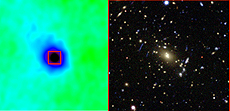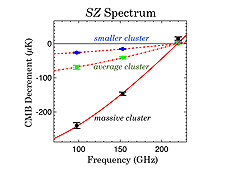Cosmic shadows in the microwave light from the big bang
 |
| Left: A South Pole Telescope image of the Sunyaev-Zel'dovich effect. The effect shows as a shadow in the cosmic microwave background from a cluster of galaxies. Right: This optical cluster image is a close-up from the Dark Energy Survey of the 2 x 2 arcmin red inset in the South Pole Telescope image on the left. |
The cosmic microwave background is the radiant heat left over from the big bang. It was emitted nearly 14 billion years ago, just 380,000 years after the big bang, and has traveled across literally the entire observable universe. This makes the CMB an ideal backlight to find the most massive, distant structures in the universe, in particular clusters of galaxies.
The most massive clusters consist of over 1,000 galaxies and have a total mass larger than 1 million billion suns. Even with its relatively impressive heft, when CMB photons pass through a cluster, only about 1 percent scatter off of gas in the cluster, but this is enough to create a distinctive "shadow" in the CMB, usually known as the Sunyaev-Zel'dovich effect.
Clusters of galaxies are the largest gravitationally bound objects in the universe and are therefore important tracers of cosmic structure growth. The abundance of clusters over the history of the universe gives information about a variety of cosmological parameters, including the properties of dark energy. Earlier in the universe's history, dark energy affected the abundance of clusters primarily through its effect on the growth of structure in the universe. Therefore, the abundance of clusters probes the dark-energy paradigm in a way that complements geometric probes such as the light from supernovae.
The South Pole Telescope (SPT) and the Dark Energy Survey (DES), designed to find clusters of galaxies, are conducting overlapping surveys of the southern sky. The SPT finds a cluster through its distinctive shadow in the cosmic microwave background. DES finds clusters more traditionally by looking for over-densities of galaxies in optical images.
Each survey, which is designed to provide the largest catalog ever of massive, distant clusters, has an unprecedented combination of depth and area. The two methods have a strong complementarity and, in combination, are expected to provide significantly improved constraints on the evolution of dark energy via its effect on the growth of structure of the universe.
The DES survey recently finished its first year of a five-year survey on Feb. 9. Preliminary analyses of a subset of the DES data have already yielded a cluster catalog with nearly 1,000 clusters. The SPT measurements of the Dark Energy Survey clusters show the distinctive shadows in the cosmic microwave background expected from the Sunyaev-Zel'dovich effect. Even with this early data, the measurements confirm that: 1) DES is successfully finding very massive, distant clusters and 2) the SPT is measuring the distinctive cluster shadow in the cosmic microwave background with a spectral distortion at the level expected from theory.
The data is just a sign of things to come from the final survey, confirming the power of the South Pole Telescope and Dark Energy Survey data sets to find and characterize clusters and giving us a powerful new tool for understanding dark energy.
—Bradford Benson
 |
| This plot shows a South Pole Telescope measurement of the Sunyaev-Zel'dovich effect of 602 DES-selected galaxy clusters. The clusters are sorted based on the number of galaxies in them: smaller, average and massive clusters. The SPT measurements are consistent with the distinctive SZ spectrum showing a shadow in the cosmic microwave background at low frequencies. |
|